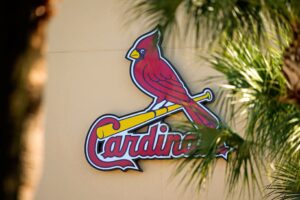New York Yankees reliever Aroldis Chapman, aka The Cuban Missile, is one of the more impactful pitchers in history. Debuting in 2010, Chapman was throwing harder than anyone has ever thrown. He pitched in 15 games in 2010, totaling 13 1/3 innings. His four-seam fastball averaged an otherwordly 100.3 mph. From 2014 through 2017, his fastball ranged from 100 mph to 101.1 mph. Chapman is the most overpowering pitcher in the history of the sport.
In addition, Chapman is a revolutionary, as he is the first pitcher to ever consistently throw 100+ mph. This is something a lot of relievers do now and so it is easy to forget his impact on the sport. Now 33 years old, Chapman still possesses elite velocity despite not being the hardest thrower in baseball. Whether it is throwing his slider more or adding a new pitch, Chapman has evolved as a pitcher with the New York Yankees and is finding new ways to get hitters out.
Aroldis Chapman Remains Dominant for the Yankees
Pitch Usage
Any time a pitcher loses 1-2 mph on their fastball from one year to the next, it is concerning. This is what happened to Aroldis Chapman. After averaging over 100 mph four straight years, his velocity decreased to 98.7 in 2018, 98.0 in 2019, and 97.8 in 2020. While that is still elite velocity, those numbers do not stand out as they would have a decade ago. In 2020, Chapman’s fastball ranked as the 12th fastest in the league (min. 50 pitches). With many relievers throwing just as hard, or harder than Chapman, hitters are used to seeing that kind of velocity. Since he is not an anomaly any more, Chapman has altered his pitch mix to be able to still get hitters out at an elite level.
2018 and 2019
Prior to 2018, Chapman threw his fastball less than 75% of the time over a 162-game season. Similar to Zack Britton with his sinker, Chapman heavily relied on his fastball while scarcely relying on his slider. His fastball decreased by 1.3 mph in 2018, prompting him to change things up a bit. The fastball usage declined from 76.9% to 65.9% and slider usage increased from 19.7% to 25.4%. He also added a sinker in 2018 that he threw 7.9% of the time. His results in 2018 were even better than they were in ’17 as he lowered his ERA from 3.22 to 2.45. Furthermore, Chapman’s FIP went from 2.56 to 2.05 and he raised his K/9 from 12.3 to 16.3, while pitching roughly the same number of innings.
In 2019, Chapman’s fastball averaged 98 mph and he threw it 58.6% of the time. His slider was at 31.3%, and his sinker at 10%. He accumulated 37 saves and 57 innings pitched, posting a 2.21 ERA, 2.28 FIP, and 13.4 K/9. Hitters batted .216 against his fastball that season, which is the worst figure of his career. Additionally, his 25% whiff rate on that pitch is the second-worst figure of his career; only his 2010 rookie season was worse. Despite a fastball that was not as effective, Chapman only allowed three homers all season and posted stellar metrics in virtually every stat category.
2020 Small Sample
2020 was a short season because Chapman missed nearly the first month of the season due to COVID-19. He only pitched 11 2/3 innings, posting a 3.09 ERA, 2.92 FIP, and 17.0 K/9. Chapman still pitched well but was not as dominant. His fastball velocity ticked down only a little bit, from 98.0 to 97.8 mph. He reverted back to his old self a bit as he threw the fastball 72.4% of the time and his slider at 21.6%. Not having a full Summer Camp to build up definitely affected him as he struggled with his slider command in his 13 appearances as well.
Hitters batted .250 against the slider with a .582 slugging percentage (SLG). Opposing hitters hit .095 against his fastball, recording only two hits in 21 at-bats. In addition, Chapman flashed a splitter in 2020. Despite only throwing it three times, he made hitters look foolish and excited fans as it pertains to his ability to throw that pitch more often moving forward.
In the postseason, Chapman remained his stellar self, with the exception of the Mike Brosseau home run. He made three appearances, pitching 4 and two-thirds innings while allowing one run and striking out eight.
Slider Results
Chapman’s slider is not an elite pitch, but it gets elite results because of two variables. First, Chapman has been so fastball reliant in his career that hitters expect the fastball and are routinely off balance when he throws a slider. Second, there was a discrepancy in velocity between his fastball and slider.
Going back to 2019, the fastball averaged 98 mph and the slider averaged 85.2 mph. In 2018, the fastball was at 98.7 mph and the slider at 86.2 mph. In the same way that a fastball-changeup pitch mix relies heavily upon the velocity difference, this is what makes Chapman’s slider dangerous. The spin rate on his slider from 2019 was 2,489 RPM. This figure ranked 156th out of all pitchers in baseball.
Despite that, hitters batted .159 with a .244 SLG and .218 Weighted On-Base Average (wOBA) against it. In 2018, they hit .109 with a .203 SLG and .165 wOBA. Even with a change in pitch arsenal, Chapman’s success with his slider will always be dependant upon how often and how hard he throws his fastball.
New Pitch
Aroldis Chapman threw only three splitters in 2020, yet it elated fans to know that he might be able to throw it more in the future. Chapman himself has talked about working on his splitter and using it more in games. With this, 2021 has gotten off to a great start for him. Granted, it has only been two innings, but he has struck out six of the seven batters he has faced.
Additionally, he has thrown his splitter five times, which is already more than all of 2020. The splitter accounts for 14.3% of the 35 pitches he has thrown thus far. The slider is currently at 31.4% and the fastball at 48.6%. Of his six strikeouts, four of them have come on the splitter; a pitch that has a 100% whiff rate. Early on, his fastball velocity is up at 99.2 mph, his highest since 2017.
While you can only read so much into two innings of work, it is clear Chapman looks different in 2021. He looks like a more complete pitcher. The introduction of the splitter will just help him evolve as he gets older and the velocity declines. What also helps is that the splitter velocity lies in between the fastball and slider, right around 90 mph. Most closers do not have three viable pitches, yet Chapman will be able to give hitters vastly different looks at the plate and throw off their timing even more. Even if he can just throw his splitter around 10% of the time, that will make a huge difference over the course of a full season.
Final Thoughts on Aroldis Chapman
In the end, Aroldis Chapman is an elite-level run preventer. His 184 ERA+ ranks as the fourth-best in history and 2.02 FIP is tied for first (min. 500 IP). Additionally, his 14.93 K/9 and 41.4% strikeout rate are the best in history. He has posted elite numbers both on and under the surface along with a fastball that is one of the best in history. Although, he is no longer a flame thrower, with the increase in slider usage and the addition of a splitter, he has evolved into a more complete pitcher. Chapman has a Hall of Fame trajectory and it is his willingness to evolve, as he gets older that will, make him a Hall of Famer.
Main Image:
Embed from Getty Images
Players Mentioned: Aroldis Chapman, Zack Britton, Mike Brosseau






